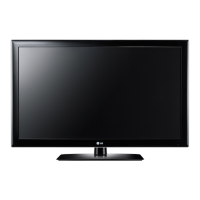
Do you have a question about the LG 42PW350 and is the answer not in the manual?
Covers troubleshooting for the 42PW350 Advanced Single Scan Plasma Display.
Circuit board operation, troubleshooting, and alignment procedures.
Covers contact details and essential safety precautions for users and technicians.
Familiarizes technicians with disassembly, identification, and layout of the plasma panel.
Details information for qualified personnel, warns about modifications, and grounding.
Advises disconnecting power before servicing and highlights weight hazards.
Lists regulations for adjustments, voltage checks, static electricity, and PDP module handling.
Explains the four-step process: Define, Localize, Isolate, and Correct.
Instructions for downloading software files and copying them to a USB flash drive.
Steps for inserting the USB drive and initiating the TV software upgrade process.
Details required remote, button presses, and password entry to access the Service Menu.
Details options within the Adjust Check menu, including Country Group and Tool Options.
Explains adjustments for White Balance, ADC, and EDID settings.
Instructions for changing the Model Number and Serial Number in the Service Menu.
Provides an understanding of 3D technology as it relates to televisions.
Guides on how to play a 3D movie and perform an initial glasses sync test.
Provides steps to troubleshoot issues related to 3D sync, including checking connections.
Details how to check for the 60Hz sync signal on the motion remote board.
Guides on checking specific pins on the P1404 connector for correct voltage levels.
Instructs on checking the 3D_SYNC line on various control board points.
Introduces the section covering disassembly, layout, and identification of circuit boards.
Provides instructions on removing the back cover, including screw count and attention to detail.
Illustrates the layout of the main circuit boards within the TV.
Labels and identifies major circuit boards like Y-SUS, Z-SUS, Main Board, etc.
Details connectors for the Panel, including part numbers.
Identifies connectors between various boards like Y-SUS, SMPS, Control, and X-Boards.
Steps for disconnecting and removing the SMPS board, including voltage readjustment.
Instructions for removing the Y-SUS board, including connector disconnect and voltage readjustment.
Steps for removing the Z-SUS board, including voltage readjustment.
Instructions for disconnecting and removing the Main board.
Detailed steps for removing the X-Drive boards, including heat sink and screw removal.
Aims for technicians to understand circuit operations, adjustments, and failure troubleshooting.
Details the sequence of signals for turning on the SMPS and related voltages.
Illustrates voltage distribution from SMPS, Z-SUS, Y-SUS, Control, and X-Boards.
Specifies the critical order for DC voltage adjustments, especially after board replacement.
Covers troubleshooting, voltage, and test points for the Switch Mode Power Supply (SMPS).
Illustrates the layout of the power supply circuit, identifying fuses, regulators, and sources.
A block diagram illustrating the sequence of signals and power-up steps.
Emphasizes that Power Supply adjustments are critical and must be performed first.
Details how to perform Va and Vs adjustments using a voltmeter and panel label.
Describes performing a static test on the power supply using light bulbs as a load.
Details how to test the SMPS sequentially by forcing power-up stages with resistors.
Provides pin identification, STBY/Run voltages, and diode check readings for P813.
Details pinout, voltages, and diode check for the P811 SMPS connector.
Covers Z-SUS board operation, locating test points for voltage and diode checks.
A block diagram showing the Z-SUS board's interaction with other components.
Explains Z-SUS waveforms (SUSTAIN, ERASE) and their relation to Z-Bias adjustment.
Guides on performing the Z-Bias adjustment using VR1, referencing panel label and heat run mode.
Step-by-step guide for testing the Z-SUS, SMPS, and Control board without the Y-SUS.
Covers Y-SUS board operation, locating voltage and diode mode test points.
A block diagram showing the Y-SUS board's role in generating Y-Sustain and Y-Drive signals.
Guides on performing the -Vy adjustment using VR502, referencing panel label and heat run mode.
Explains how to capture and observe Y-Drive waveforms for adjustment purposes.
Instructions for adjusting VR601 to match the SET-UP waveform.
Instructions for adjusting VR401 to match the SET-DN waveform.
Explains how to test the Y-Scan signal, cautioning against using C213 for adjustments.
Instructions for testing the Control Board's 5V supply and video output.
Warns against running the TV with the heat sink removed, as it protects the TCPs.
Describes the Main Board's components, functions, tuner, and software upgrades.
Shows connections from SMPS to various boards (Z-SUS, Y-SUS, Control, X-Boards).
Illustrates signal paths and connections between Y-SUS, Y-Drive, and Panel.